2018 Honda Goldwing Touring test: more watts, less cotton wool
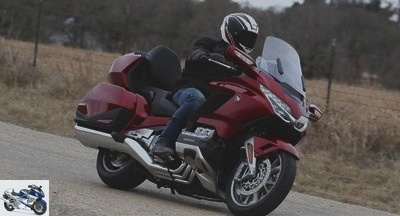
On an exceptional motorcycle, exceptional measures: after 17 years without major evolutions, the Honda Goldwing is reinventing itself with great reinforcements of technology to – finally – offer the sophistication expected of such a limousine on two wheels. A little more powerful and much lighter, the 2018 Gold Wing is above all more dynamic! Test.
2018 Goldwing Touring Test – Page 2 – Dynamics
It was in Austin, Texas (United States), that Honda set off to present its new 2018 Goldwing to the press. A geographic location dictated by the size of the American market: out of the 20,000 Goldwing produced each year (yes, anyway), "80%" are sold across the Atlantic. Europe represents "10%" – of which a major part in France, the first European market – and the rest of the world accounts for the remaining "10%".
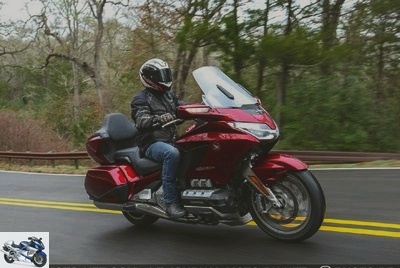
Bad pick, alas, in terms of destination: apart from the fact that the scarcely colored and rectilinear landscapes are sorely lacking in interest, the weather forecast was in a gloomy mood. The "drizzly" sky and the low temperatures (from 4 to 12 ° C depending on the on-board computer) encourage you to activate the saddle and the heated grips … which are just powerful enough to warm your hands..
The advantage of these conditions is to be able to experience the protection of the 2018 Goldwing, in particular its new electrically operated windshield. Easy to handle, fast and quiet, this screen provides excellent deflection in the high position, protecting the torso and helmet of the pilot and his passenger without the phenomenon of thrust in the back.
On the other hand, the arms and hands are better protected on the old Goldwing, which MNC took over during this test to corroborate our feelings. The same goes for the legs, now slightly exposed on the outside of the knees. The degree of protection remains excellent, but the impression of being in a "veranda" sheltered from all the elements is no longer … The predictable downside of reduced volumes, especially at the front !
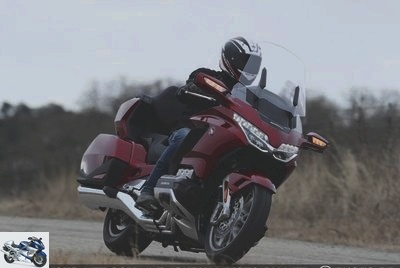
Another notable change: the ergonomics of the motorcycle are evolving, with a significant impact on its comfort. The handlebars are much less curved and taller, but also narrower "about 15 mm" according to Honda. The result is a more forward posture, an aspect reinforced by the 5 mm rise in the saddle height (745 mm).
This seat also abandons its old hyper enveloping format – custom way – to give way to a upholstery that is certainly very welcoming, but less soft. The lumbar support loses what we gain in mobility around the tank, whose capacity drops by 3.9 liters (21.1 l). The bike is considerably thinner, allowing a 1.75m rider to touch the ground easily..
The passenger also inherits a new very comfortable seat, but less spacious and padded. The guest no longer feels this unique sensation of traveling comfortably in their favorite chair: this time, it is the customers of the motorcycle taxis who may not appreciate !
To sum up, the pilot is more "encrusted" in the old one – as in a cozy cocoon – while one lands "on" the new one, in a more road posture. This change of direction means that the general comfort goes from simply exceptional to "only" excellent….
A rigorously dynamic cycle part
This new ergonomics – very well thought out, moreover – does not alter one of the historic strengths of the Goldwing: its fabulous balance. The 2018 vintage remains disconcertingly easy to handle given its mass (383 kg with the DCT and the airbag). The motorbike spins at low speed like a displacement twice as small, aided by its very low center of gravity.
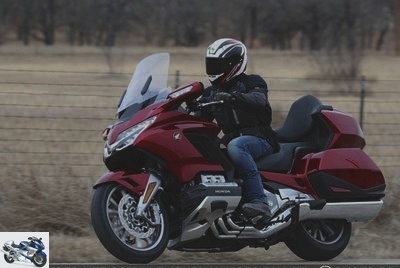
Thanks to its many pounds lost (-34 kg!), Traveling with the engine off and placing on the central stand are greatly facilitated, as are maneuvers in reverse. The latter’s electric motor – quieter – now engages from the left stalk. Getting the Goldwing out of a tilted parking lot is much less stressful and physical !
Launched at low speed, on the other hand, the novelty reveals a slightly lower handling: MNC has multiplied the maneuvers and the U-turns with the two generations to make sure, and the difference is very real. The old one – freestanding from 0.1 km / h! – requires a little less effort to tilt, aided by the upper lever arm deployed by its wide handlebars closer to the bust.
Other geometric parameters are at the origin of this subtle evolution: the wheelbase has been lengthened by 5 mm (1695 mm), the caster angle opens from 29.15 to 30.5 ° and the rear tire goes from 180 to 200 mm. So many factors favoring stability, to the detriment of pure handling.
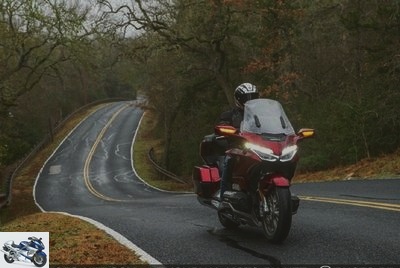
One last piece of data also plays a role: the new unconventional front end of the 2018 Goldwing, physically heavier than the old "good old" telescopic fork. The double triangle weighs down the steering at very low speed, but in return gives it remarkable rigidity and precision..
The more the speed increases, the more the progress is noticeable: the novelty is incomparably more efficient when entering a curve, including on the brakes thanks to the separation of the damping and steering functions. Tipping it from one curve to another is more obvious, as is keeping it on the angle thanks to its stability to make a TGV blush. !
The additional rigor offered by the damping confirms the superiority of the new model, whose new piloted suspensions are simply bluffing of approval. Correlated to the driving mode, they offer a spectacular big difference between the ultra-comfort of the "Rain" and "Econ" mode and the almost sporty dynamism of the "Sport" mode (see details in our).
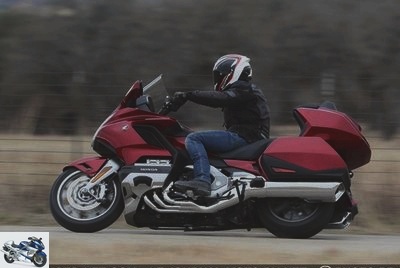
More "lazy" in the winding, the old Goldwing is more heckled in fast driving when the one that succeeds it maintains its course and its attitude in all circumstances. The fact remains that the "old" Goldwing 2017 flies over each irregularity like a real "conveyor belt", admittedly sometimes a little sluggishly but without ever bringing up the slightest bump to the pilot….
The 2018 vintage is not as "canapesque" because of its compromise of stronger suspensions, but also because of its less padded saddle. The difference is felt particularly on short and dry shocks (type passage on a manhole cover), that the new front axle collects more sharply like all kinematics of this type..
The change in orientation of the Goldwing also materializes under braking, quite simply flawless: the 6-piston radial calipers very logically outclass the old 3-piston elements, offering moreover excellent feel to the lever. Consistency is also at the rendezvous, which bodes well for busy trips in duo.

To avoid spoiling anything, the excellent combined ABS (D-CABS) allows in most cases to use only the rear brake: super powerful and easy to dose, the latter combines its efforts with the front to offer formidably powerful slowdowns. The bike remains firmly planted on its supports thanks to its successful suspensions, even in the event of brutal braking.
Despite wet conditions, this D-CABS was discreet and its rare interventions finely calibrated. It is different with the traction control which intervenes in a too preventive way despite a traction beyond criticism: each acceleration pressed on the first two reports causes a brief cut of power, fortunately quite soft..
Love story between the 6-cylinder and the DCT !
The powerful thrust provided by the six-cylinder partly explains the cautious interventions of this unprecedented traction control: the "flat-six" is considerably muscular, especially between 4000 and 6000 rpm. Thanks to the general reduction in weight and engine inertia, the 2018 Goldwing leaves the old model in place in the second part of the tachometer.
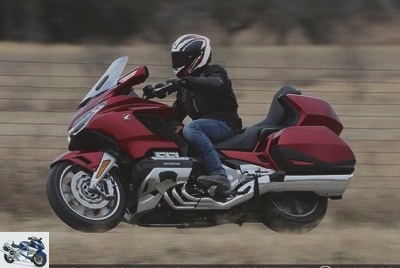
Below 3000 rpm, on the other hand, the gain of 8.2 hp and 3 Nm of torque is less obvious due to a fairly linear power distribution. On the last report – very, very elongated: the speed decreases by 700 rpm! -, acceleration leaves you hungry for the enormous displacement of 1.8 liters: it is better to downshift before doubling between 90 km / h – just under 2000 rpm in 6th – and 130 km / h, at 2750 tr / mn in 6th.
The reactions of the double clutch gearbox confirm this observation: in this range of revs, the DCT drops two gears when the throttle is fully open! In "Sport" mode, the most dynamic, the system thus keeps the needle of the tachometer readable above 3000 rpm.
Result: the bike remains in fifth up to 100 km / h, prompting to pass the following gears "manually" from the triggers on the left stalk. The intervention validates the speed and the exquisite softness of this third generation of DCT, whose ability to eradicate any break in load blends perfectly with the majestic breath of the six-cylinder.
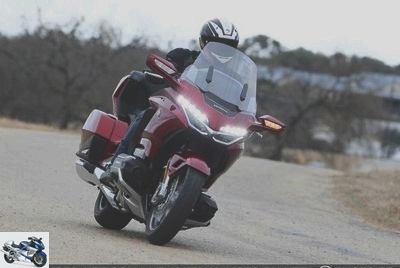
This exceptional block has also retained its record elasticity, which allows it to propel the crew at idle – at 750 rpm – in the last gear at 35 km / h. The Goldwing is however a tad rougher at these very low (under) revs, largely due to the slight transmission jerk felt when opening the throttle on the manual gearbox version..
If the progress made on the new clutch in terms of smoothness and progressiveness is to be welcomed, it is a little less the case of the new electronic accelerator. The old cable system offered a smoother dosage whereby the connection between the right hand and the gimbal was crystal clear.
The "Wingers" will see there an additional reason to prefer the manual gearbox DCT double clutch, which shines by its softness on the gas net. Added to this are the new "Maneuver" modes offered by the DCT, thanks to which the Gold moves forward or backward at very low speed from the "+/-" triggers on the left. Convenient.
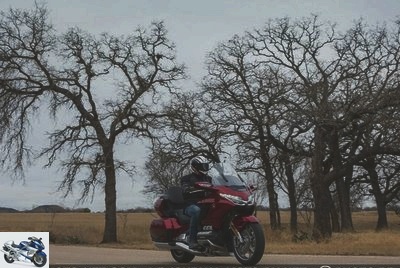
The DCT is particularly appreciated by selecting the "Tour" driving mode, which gives access to the best compromise to savor the extraordinary capacities of the six-cylinder. MNC clearly preferred it to the lymphatic mode "Rain" – which passes the seven gears at 1500 rpm, or 70 km / h on the last! – and in "Sport" mode which is almost too nervous with regard to the philosophy of the bike (frequent downshifts to stay in the laps).
At the end of this first contact, mainly carried out on American highways (expressways limited to 110 km / h), MNC measured at the pump an average consumption of 6.23 l / 100 km, or about 0.6 l / 100 km more than announced by Honda (5.6 l / 100 km). An acceptable difference, much more in any case than the surprisingly high noise level of the engine…
If the six-cylinder in-line renews to our delight its flattering serious sound, the engine manufacturers are a little too loose on the volume! At mid-speed, the engine’s vocalizations take the form of a powerful purr which becomes tiring. Another passable "acoustic" detail: the rolling noise emitted by the front tire during strong decelerations.

It’s a matter of taste, of course, but MNC believes that a motorcycle such as the Goldwing must deploy all the assets in the service of the comfort of its pilot and its passenger. However, a noisy environment does not exactly fall within these specifications…
However, music lovers will appreciate that the soundtrack of the new Goldwing finally goes quite well with the continuous "gurgling" engendered by the V8 engines which are very popular in American road traffic. !
Verdict: spirit, are you still here ?
The question deserves to be asked, because let things be clear: the Goldwing as we have known it for several decades no longer exists! Honda fully accepts this new bias, explaining wanting to rejuvenate the image and behavior of its flagship road. On this point, it’s a total success.
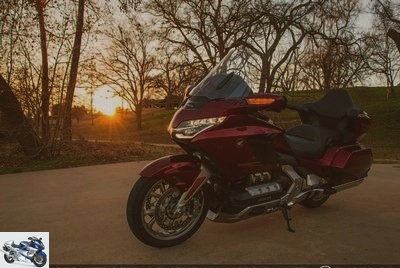
The 2018 GL1800 Goldwing Touring is undoubtedly better in virtually every dynamic area, except sheer handling where the old one manages to hide its extra pounds behind its almost magical balance..
And all the difference between the new and the old lies precisely in this touch of magic which made each journey with the "Golden Wing" a unique experience. Anyone who has ever ridden it has asked this question: "But how did Honda go about making a motorcycle over 400 kg so obvious and fun to ride?" It was a real sleight of hand !
The 2018 Goldwing Touring appears more pragmatic, more efficient … but less magical. More dynamic, of course, more sophisticated too. But this unique bridge that it stretched between ultra-customs stuck in their heaviness and road motorcycles not as comfortable has shrunk considerably..

Some "Wingers" will be delighted with this transformation and will salute Honda for having created a kind of super "Pan Wing". Others will harbor mixed feelings in front of the negative effects involved, in particular the loss of protection and the capacity to carry. That is to say two areas in which the previous "Gold" referred…
Everyone will also notice the increase of 2,300 euros between the 2017 model (€ 30,699) and the 2018 Goldwing Touring in a manual gearbox (€ 32,999) … As for the Goldwing Touring with DCT box and the airbag, it’s downright. € 35,999! Yet it is on this version that Honda France has the strongest ambitions, counting on "60% of sales" against "25%" in manual gearboxes..
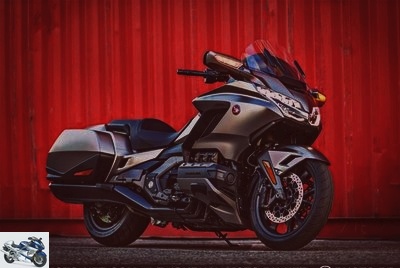
The remaining "15%" concerns the "short" Goldwing above, that is to say the bagger version formerly called. This stripped-down Goldwing has a truncated windshield and ignores the top case and other equipment like traction control.
So many prices to compare with the 25,650 € of the (30,700 € for the most comfortable Exclusive version), the 29,950 € of the (42,690 € in the CVO Limited version with the Twin 114) and the 30,600 € of the (€ 37,990 for Elite version, with special paint and logo in 23 carat gold leaf)…
- MNC technical update on the 2018 Goldwing Touring in .
Related articles
-
2018 Honda Goldwing Touring test: more watts, less cotton wool On an exceptional motorcycle, exceptional measures: after 17 years without major…
-
2018 Honda Goldwing Touring test: more watts, less cotton wool On an exceptional motorcycle, exceptional measures: after 17 years without major…
-
Roadster – Test Honda CB1000R 2018: change of universe – Test CB1000R 2018 – Page 2: Dynamics
2018 Honda CB1000R Test: Change of Universe Ten after making headlines, the Honda CB 1000 R is looking for a new style. Storing her modern influences in…
-
2018 Honda Goldwing Touring test: more watts, less cotton wool On an exceptional motorcycle, exceptional measures: after 17 years without major…
-
Road – First photos and info on the 2018 Honda Goldwing and Bagger? – Used HONDA
First photos and info on the 2018 Honda Goldwing and Bagger ? Possible stolen photos of the new Goldwing 2018 are circulating, relayed by professionals…
-
Honda X-ADV test: the Integra takes the right path Five years after the Integra, the first maxi-scooter built from a motorcycle as convincing dynamically…
-
Duel BMW K1600GTL Vs Honda GoldWing 2018: Cruising Face Off… Forget Commander Stubing and his Love Boat . Rather, embark with Site for a cruise that is…
-
Duel BMW K1600GTL Vs Honda GoldWing 2018: Cruising Face Off… Forget Commander Stubing and his Love Boat. Rather, embark with Site for a cruise that is…
-
Test Yamaha Tracer 900 and Tracer 900 GT 2018: the way of wisdom Unclassifiable, the Yamaha Tracer 900? This sporty road bike derived from the stormy…
-
Honda CBR1000RR / SP 2017 test: neither gross nor submitted ! Forget the old CBR1000RR lacking in performance and technology: Honda celebrates 25 years…